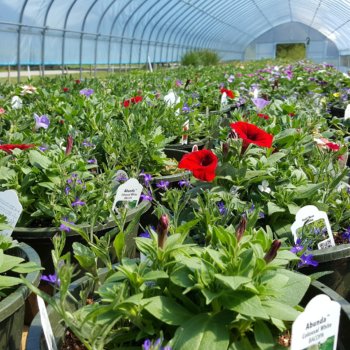CambridgeHOK’s heating options for commercial growers

With winter approaching, ensuring a plants optimum climate is achieved is imperative. Check out CambridgeHOK's range of heating options for commercial growers.
25 October 2018
Every plant has its own optimum microclimate (the ideal conditions to promote growth and yield) – climate control is about ensuring this climate is maintained.
Growers need complete control to eliminate as many variables as possible; this is more difficult to achieve in a glasshouse than in a fully controlled environmental room, due to the effects of ambient conditions.
In order to maintain each plant’s micro-climate we must control the temperature, humidity, level of CO2, airflow control, irrigation and cooling. CambridgeHOK can integrate it all into a sophisticated environmental control computer system.
The climatic controls CambridgeHOK can offer are:
- Heating by gas, oil, Biomass, ground source heat pumps, air source heat pumps or CHP.
- Cooling by ventilation, direct expansion refrigeration, chilled water, absorption chillers or high pressure fogging systems.
- Humidification by steam, ultrasonic, misting, or high pressure fogging.
- De-humidification by absorption, direct expansion dew point control.
- CO2 by bottled CO2 (used for low level CO2 usage) or from scrubbed flue gases.
Heating Systems
Together with irrigation, thermal / blackout screens, CO2 distribution and control systems, the installation of heating systems should be specifically designed to achieve the required growing environment for your crop.
Heating installations are custom-made for Commercial Glasshouse Production, Garden Centres, R&D facilities for Colleges and Universities as well as innovative systems for growing such as vertical farms.
Turnkey projects, stand-alone systems, feasibility studies, evaluation of energy requirements and use of heat recovery systems and bio-fuels all form part of the service provided. Plant production including salad crops, bedding, herbs, flowers, tropical, propagating, and crops for tests and trials all require individual consideration when designing optimum heating installations.
Warm Air Heating
Warm air heating is used mainly where an overall ambient temperature needs to be maintained. This can be in the form of freestanding air recirculating heaters firing on natural gas, propane or light oil and can be effective where less sophisticated control is required. Units will have independent flue systems and may also be used for ventilation during summer months.
Hot Water Systems
Pipe Rail Systems
Generally used in the commercial production of certain salad crops (i.e. tomatoes, cucumbers, peppers, etc) and are also used with fruit crops such as strawberries. These installations provide controlled heating from pipework which is located at ground level in specially designed floor brackets that form a rail system. Such installations enable the user to attend to all crop management and be able to pick the produce from electrically operated trolleys running on rails between the crop rows.
Monorail Systems
This installation uses pipework located at high level giving the crop radiant heat whilst maintaining clear access below, this enables crops to be transferred without obstruction. This type of system is often used in conjunction with lower temperature systems to give a higher heat output and maintain desired temperatures.
Bench and Floor Heating
To enable some growers to provide low grade heat to roots and localised heat to plants. Heating systems may be incorporated in bench tops and in floor areas beneath the plants. This is achieved by circulating low temperature heating water in plastic pipework within the floor construction or within bench tops. (Care must be taken not to overheat and damage plant roots which can be avoided by the use of close control of the system).
Grow Tube Heating
This installation comprises smaller heating tubes which are controlled independently from the main heating system. Located either in close proximity to crops being grown, these tubes provide a localised heat boost and assist in the control of humidity. These tubes are usually steel, although polypropylene tube is an option for some fruit crops. Automated lifting systems are often employed where grow tubes are installed to give radiant heat over crops grown on benches.
Feed Water Heating
Where controlled drip feed irrigation systems are provided to crops, it is essential that this is not supplied below the required temperature as this can be detrimental to plant growth. To avoid this, you can pass feed-water through a heat exchange or install a heating coil in the feed-water storage tank.
Heat Generation and system options
Various heat sources are available to provide heat requirements for a modern glasshouse project, as well as several energy efficient system alternatives can be incorporated within the design to suit individual client needs. These installations may range from small heat pumps / AD plant and renewable energy to complex CHP, Biomass boiler and large heat storage buffer tank systems for large commercial nurseries.
Modern production installations will often incorporate pre-insulated underground mains, large insulated heat storage tanks with integral expansion system, monitored water treatment systems and CO2 distribution systems generated from in house plant room.
Facilities and services offered by CambridgeHOK
- Liaise with Clients.
- Site surveys.
- System design.
- Material specification.
- Estimating.
- Preparation of installation drawings.
- Submitting Quotations.
- Contract agreement.
- Material ordering / labour programming.
- Site supervision.
- Commissioning of installations.
- Sundry Sales.
- Modifications to existing systems.
- Assessment of Insurance Damage.
Renewable Technologies
Reducing energy costs and CO2 emissions is something which is very much in the forefront of growers and developers minds, and as a leading horticultural company CambridgeHOK have developed the expertise to offer the complete package.
Predominantly the second highest cost to the grower is energy, and with costs spiralling it is crucial to look into alternative energy production. With the available support of the government backed Renewable Heat Incentive (RHI) growers are turning toward Bio-Boilers on a large scale.
Working closely with their partners at Energy4Growth we are able to specify and design energy solutions to meet the heat and CO2 profiles for your growing needs.
With paybacks of approximately 3 years against oil and 5 years against natural gas, the RHI changes the way we think when it comes to maximising crop yield against energy costs.
With the in-house expertise, not only encompassing experienced M&E Engineers, but also Structural and Civil Engineers, CambridgeHOK can design and install the complete energy solutions with all of the associated services. CambridgeHOK have worked on multiple projects including:
- Large Scale Biomass Boilers.
- Absorption Chillers.
- Bio-Gas CHP.
- Anaerobic Digesters.
CambridgeHOK are looking forward to working with growers as we together develop schemes to integrate new technologies with new and existing glasshouse systems.



 Print
Print









Fans 0
Followers